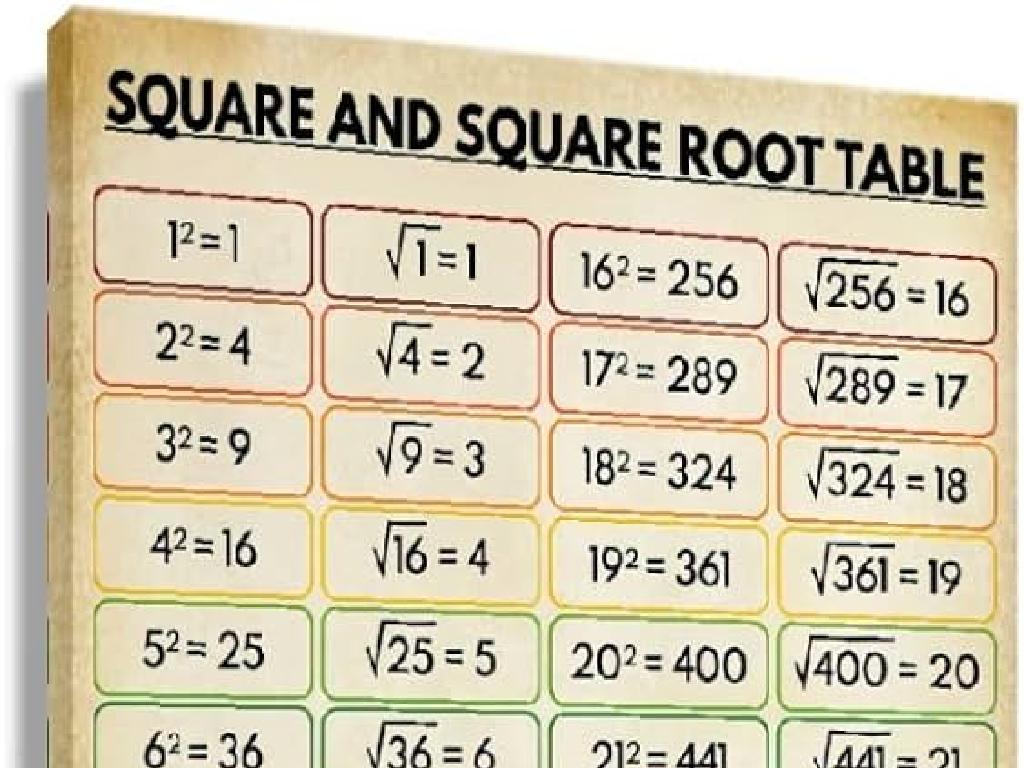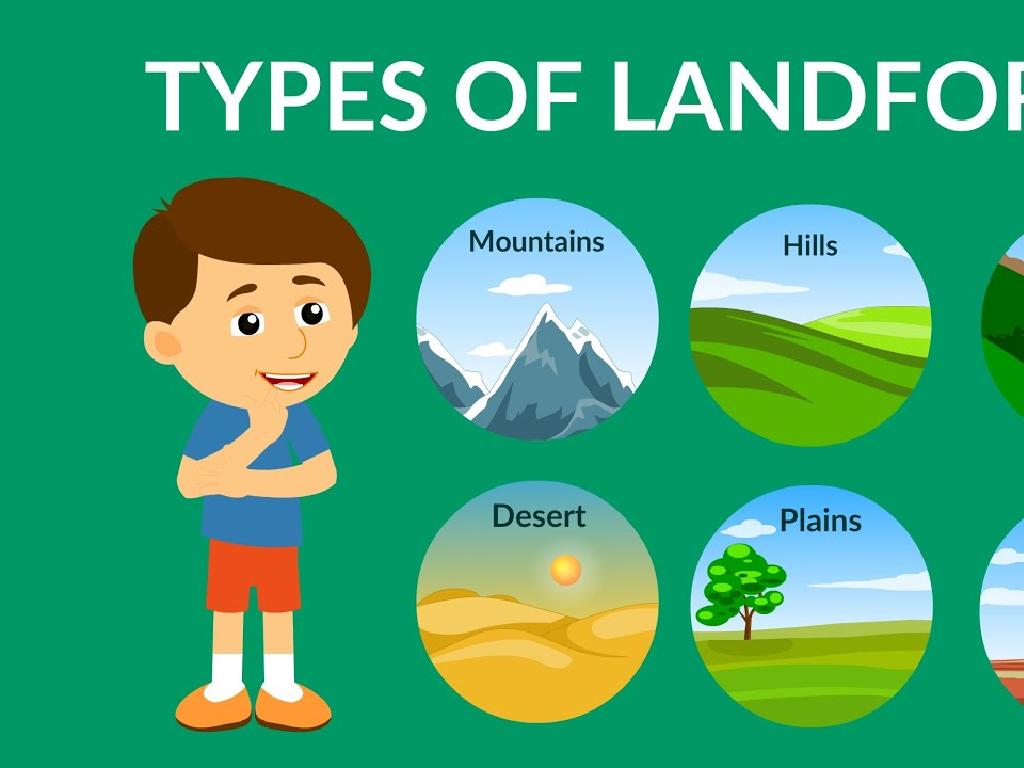Write Variable Expressions: One Operation
Subject: Math
Grade: Sixth grade
Topic: Expressions
Please LOG IN to download the presentation. Access is available to registered users only.
View More Content
Introduction to Variable Expressions
– Understanding variables in math
– Variables are symbols that represent numbers
– Defining an expression
– An expression is a math phrase combining numbers and/or variables
– Creating expressions with one operation
– Use addition, subtraction, multiplication, or division to form an expression
– Practice with real examples
– Example: If x represents books, x + 5 could be 5 more books
|
This slide introduces the concept of variable expressions to sixth-grade students. Begin by explaining that variables are symbols, like x or y, used to represent numbers in math. Then, define an expression as a combination of numbers, variables, and operations without an equal sign. Show how to create an expression using just one operation (addition, subtraction, multiplication, or division). Provide real-life examples to help students understand the practical use of expressions, such as calculating the total number of books if 5 more books are added to an existing amount represented by x. Encourage students to come up with their own examples and to practice forming expressions with different operations.
Understanding Variables in Expressions
– Variables represent unknowns
– Think of a variable as a mystery number
– Letters like x, y, z symbolize variables
– x might be 5 in one problem, but 10 in another
– Variables can assume various values
– As situations change, so do variable values
– Variables are key in expressions
|
This slide introduces the concept of variables, which are fundamental in understanding algebraic expressions. A variable is a symbol, usually a letter, that stands in for an unknown number. It’s important for students to grasp that variables can change and represent different values depending on the situation. Emphasize that variables are not fixed; they are placeholders that allow us to write expressions that can solve a variety of problems. Provide examples of simple expressions using variables, such as 5 + x or y – 3, and explain how the value of the expression changes as the value of the variable changes.
Writing Variable Expressions: Basic Operations
– Review basic math operations
– Addition (+), subtraction (-), multiplication (×), and division (÷)
– Understand operation symbols
– Symbols guide us: + for add, – for subtract, × for multiply, ÷ for divide
– Write expressions with variables
– Use symbols to write expressions like ‘n + 3’ or ‘4 × m’
– Practice with examples
– Example: If ‘n’ represents your age, ‘n + 2’ is your age in two years
|
This slide is aimed at refreshing students’ memory of the four basic operations in mathematics, which are crucial for writing variable expressions. Emphasize the importance of understanding the symbols for each operation as they are the building blocks for creating expressions. Introduce the concept of using variables like ‘n’ or ‘m’ to represent unknown quantities and demonstrate how to incorporate them into expressions with one operation. Provide clear examples to illustrate the concept, such as using age or items in a group. Encourage students to create their own variable expressions and share them with the class for further practice.
Writing Expressions with One Operation
– Understanding expressions
– An expression is a math phrase combining numbers and variables.
– Components of an expression
– They include numbers, variables, and one math operation like +, -, *, or /.
– Examples of single-operation expressions
– For instance, 3 + x, y – 5, 4z, and 12 / w are all expressions with one operation.
– Creating your own expressions
– Try writing expressions using different numbers, variables, and a single operation.
|
This slide introduces students to the concept of mathematical expressions with a single operation. Begin by explaining that expressions are like sentences in math, made up of numbers and variables combined with operations such as addition, subtraction, multiplication, or division. Provide clear examples like 3 + x, where 3 is a number, x is a variable, and + is the operation. Encourage students to identify parts of expressions and understand their roles. Then, challenge them to create their own expressions using the components discussed. This activity will help solidify their understanding of expressions and prepare them for more complex algebraic concepts.
Creating Our Own Expressions
– Choose any variable
– Select a numerical value
– Pick a mathematical operation
– Combine them into an expression
– For example, with ‘a’, 7, and multiplication, we write ‘7a’
|
This slide is aimed at helping students understand how to create simple algebraic expressions using one operation. Start by explaining what a variable is a symbol that can represent any number. Then, guide students to choose a number that they will combine with their chosen variable. Next, they should select an operation (addition, subtraction, multiplication, or division) to combine the variable and the number. Finally, demonstrate how these elements come together to form an expression, such as 7a, which represents ‘7 times some number a’. Encourage students to practice with different variables, numbers, and operations to build their confidence in writing variable expressions.
Practice Time: Writing Single-Operation Expressions
– Write expressions with one operation
– Use addition in variable expressions
– Example: x + 5, where x is any number
– Use subtraction in variable expressions
– Example: y – 3, subtract 3 from y
– Use multiplication or division in expressions
– Choose either multiplication (z * 2) or division (w / 4)
|
This slide is designed for a practice activity where students will apply their knowledge of writing variable expressions with one operation. Start by reminding them of the basic operations: addition, subtraction, multiplication, and division. Encourage them to write expressions using variables and one operation only. Provide examples for each operation to guide them. For instance, ‘x + 5’ could represent 5 more than a number, ‘y – 3’ could represent 3 less than a number, ‘z * 2’ could represent double a number, and ‘w / 4’ could represent a number divided by 4. Have students create their own expressions and share with the class to reinforce their understanding.
Real-Life Applications of Variable Expressions
– Solve real-world problems
– Use variables in expressions
– Variables like ‘x’ stand for a number we don’t know yet
– Example: money earned
– If you start with x dollars and earn $5, we write it as ‘x + 5’
– Expression represents value
|
This slide aims to show students how variable expressions are used in everyday situations. Start by explaining that a variable is a symbol that represents a number we don’t know yet or that can change. Then, present the example of earning money to illustrate how we can use ‘x’ to represent an unknown amount of dollars. Explain that if you have x dollars and earn 5 more, the expression ‘x + 5’ captures this situation. Encourage students to think of other real-life scenarios where they might not know the exact number but can describe the situation using a variable expression. This will help them understand the practical use of algebra in daily life.
Class Activity: Expression Creation
– Pair up and create five expressions
– Use only one operation in each
– Share your expressions with the class
– Explain your thinking behind the expressions
– Discuss variable value changes
– How does altering the variable affect the result?
|
This activity is designed to encourage collaboration and deepen students’ understanding of variable expressions with one operation. Students will work in pairs to create five unique mathematical expressions, each using a single operation (addition, subtraction, multiplication, or division). After crafting their expressions, pairs will present their work to the class, fostering a collaborative learning environment. The discussion portion will focus on the impact of changing the variable’s value on the overall value of the expression, reinforcing the concept that variables are placeholders that can represent different numbers. Possible activities for different pairs might include creating expressions with different operations or comparing expressions to see how a change in the variable affects each one differently.
Conclusion & Homework: Variable Expressions
– Recap variable expressions
– Homework: Create 10 expressions
– Combine numbers and variables with one math operation
– Use one operation in each
– Operations include addition, subtraction, multiplication, or division
– Solve for a chosen variable value
– Pick a value for the variable and find the expression’s result
|
As we conclude today’s lesson, remind students of the key concepts of writing variable expressions with one operation. For homework, they are tasked to create 10 unique variable expressions, ensuring they use only one operation in each. This could be addition, subtraction, multiplication, or division. They should then choose a value for the variable in each expression and solve it. This exercise will help reinforce their understanding of variable expressions and the use of operations. Encourage creativity in their expressions and remind them to show their work for each solution.






